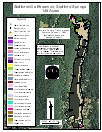Staffordville Reservoir, Stafford Springs - 2005
Staffordville Lake is a 149-acre body of water. The eastern side of the lake is residentially developed; homes line the shore, and most lawns extend to the edge of the lake. The north end of the lake is more forested; homes are set farther back from the shore and are surrounded by trees. Much of the northern end of the lake’s west side is protected by forest, although many houses have been built on the southern end. There is a public beach at the south end of the lake.
The diversity of aquatic plants was found to be high during our August 2005 survey. A total of 29 species were recorded, all of them native. Aquatic plants grew sparsely through most of the lake; however, plants became very dense in a cove to the west off the lake’s northern end. The northern half of this cove supported dense cover of floating-leaved species, primarily white water lily (Nymphaea odorata) and yellow water lily (Nuphar variegata), under which grew common bladderwort (Utricularia macrorhiza). The southern half of the cove supported greater diversity and very high abundance of submerged species, including marsh mermaid weed (Proserpinaca palustris), purple bladderwort (Utricularia purpurea), small pondweed (Potamogeton pusillus), western waterweed (Elodea nuttallii), and slender naiad (Najas flexilis). The floating-leaved watershield (Brasenia schreberi) and floating-leaf pondweed (Potamogeton natans) occurred in this area as well.
Diversity in the shallow water at the north end of the lake itself was very high. White water lily grew in several patches along the shore, and eelgrass (Vallisneria americana) and arrowhead (Sagittaria species) occurred in deeper water. Little floating heart (Nymphoides cordata) grew near the shore in one location. Other species observed in the area included watershield, small pondweed, ribbon-leaf pondweed (Potamogeton epihydrus), and small waterwort (Elatine minima). Few species grew along the eastern shore of the lake, and these were almost all submerged. The most frequently found species in the area was golden hedge-hyssop (Gratiola aurea), which grew in very shallow water or exposed on the shore. Other species that occurred along the eastern shore as isolated plants or small patches included spiney-spored quillwort (Isoëtes echinospora), slender naiad, pickerelweed (Pontederia cordata), arrowhead, eelgrass, needle spikerush (Eleocharis acicularis), and ribbon-leaf pondweed. Charaphyte carpeted the bottom in deeper water.
The western shore of the lake supported even fewer plants, especially where the shore was steep and rocky. Purple bladderwort occurred in water 3 - 6 feet (1-2 m) deep, with charaphyte in deeper water. The south end supported more dense growth of plants than did either side of the lake. Western waterweed, arrowhead, needle spikerush, golden hedge-hyssop, and small pondweed all were collected in the shallow water. Charaphyte grew thickly on the bottom and native low watermilfoil (Myriophyllum humile) was collected in one location.


